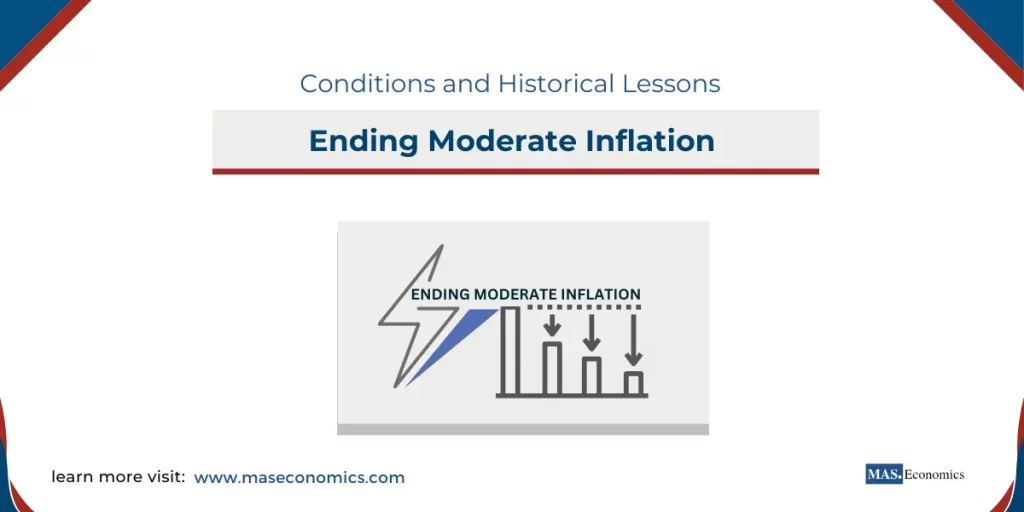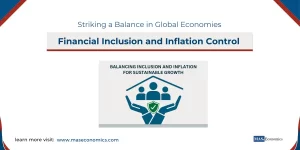Moderate inflation is often considered manageable, but it poses challenges, especially for economic stability. Though less chaotic than hyperinflation, moderate inflation can have significant consequences if left unchecked. How can central banks effectively end moderate inflation, and what conditions favor successful stabilization?
Understanding the conditions for ending moderate inflation, the role of central banks, historical lessons, and strategies used to achieve stability offers insight into managing this kind of inflation effectively.
Understanding Moderate Inflation and Its Challenges
What Is Moderate Inflation?
Moderate inflation refers to a period of consistent price increases that are noticeable but not extreme. It differs from high or hyperinflation, where prices may rise uncontrollably and erode public confidence in the currency. Moderate inflation tends to be viewed as manageable and sometimes even beneficial, as it often comes with periods of economic growth.
Why Is Ending Moderate Inflation Important?
Though moderate inflation may not result in immediate instability, its long-term effects can be harmful if not controlled. It can create an inflationary bias, encouraging excessive risk-taking in investments and making it harder for central banks to conduct monetary policy effectively. Unchecked, moderate inflation can erode purchasing power over time, affect income distribution, and eventually escalate into more significant economic problems.
Conditions Favoring Stabilization of Moderate Inflation
Strong Monetary Constitutions
Historically, the most successful instances of ending moderate inflation have occurred when central banks or monetary systems adopt strong monetary constitutions. These include frameworks that significantly limit the ability of the government to manipulate the monetary system for short-term political or fiscal gains.
Monetary Constitutions
A monetary constitution refers to rules and regulations designed to limit inflationary tendencies. Examples include establishing independent central banks or adopting specific monetary standards, such as the gold standard. These constitutions are essential because they bind the hands of political authorities who may otherwise be tempted to pursue inflationary policies for temporary benefits, such as economic stimulus during elections.
Political and Social Will
Ending moderate inflation often requires the political will to implement strict policies, which can sometimes be unpopular. Historical evidence suggests that countries tend to adopt stable monetary policies either through imitation of successful monetary systems or as a result of political pressure to restore stability.
Restoring Stability After Crisis
One of the key factors in effectively ending moderate inflation is the presence of a widely accepted need for a return to economic stability. For example, periods following wars or other upheavals often lead to a collective demand for a return to economic normalcy, which encourages governments to adopt policies that stabilize inflation. This was notably seen after World War I when countries such as the United Kingdom and France took steps to re-establish stable monetary regimes.
Historical Lessons on Ending Moderate Inflation
The Role of Historical Monetary Constitutions
Throughout history, several countries have successfully stabilized their economies by introducing sound monetary regimes after periods of moderate inflation. These regimes often involved adopting new monetary standards at a lower parity or returning to older, stable parties.
Example: Post-War Restoration in Europe
United Kingdom (Post-World War I)
Following the war, many countries struggled with the economic impact of inflation. In the UK, efforts were made to return to the pre-war gold parity in 1925. This was driven by the desire to restore the pound’s international reputation and maintain its status as a reliable currency for trade and finance.
France (1920s)
France, after World War I, experienced significant inflation. By 1926, the French government took strong measures to stabilize the franc, including fiscal tightening, reducing the amount of banknotes in circulation, and returning to a fixed exchange rate. The French case highlights how the undervaluation of a currency can favor economic recovery if the government capitalizes on stabilizing conditions to restore confidence in the monetary system.
Moderate Inflation and Imitation of Successful Models
Another pattern seen historically is the imitation of successful monetary models by countries trying to stabilize their moderate inflations. For example, countries often tried to emulate the success of adopting the gold standard in the 19th century or implementing currency boards in the 20th century, which had proven effective in achieving price stability.
Adopting the Gold Standard
In the 19th century, several countries adopted the gold standard as a way of ensuring monetary stability, aiming to mimic the success of countries that had maintained stable prices through this mechanism. This move helped restore confidence among domestic and international stakeholders in the country’s financial stability.
Central Bank Policies to End Moderate Inflation
Reducing Money Supply Growth
One of the most effective tools for ending moderate inflation is reducing the growth of the money supply. Central banks must take deliberate actions to slow down the issuance of money, thereby cooling off inflationary pressures. Historical examples highlight the importance of aligning the domestic money supply with those of major trading partners.
Example: Argentina in the 1890s
In Argentina, during the late 19th century, moderate inflation was initially driven by an economic boom funded through rising foreign debts. After a major financial crisis that resulted in the collapse of key banks, the government implemented strict measures to reduce the amount of money in circulation. This stabilization was critical in bringing inflation under control, illustrating how reducing money supply growth can have immediate and effective results.
Balancing Exchange Rates
Another crucial aspect of ending moderate inflation is the effective management of exchange rates. Maintaining or restoring an exchange rate at an appropriate level can help avoid the negative consequences of overvalued or undervalued currencies. Undervaluation, in particular, can benefit export and import-competing industries, creating favorable economic conditions during stabilization.
Exchange Rate Management in Czechoslovakia
During the 1920s, Czechoslovakia successfully ended moderate inflation by stabilizing its currency at an undervalued rate, which encouraged economic growth and bolstered foreign reserves. The Czech experience underscores the importance of choosing an exchange rate that supports the broader goals of economic stability and growth.
Challenges and Risks in Ending Moderate Inflation
The Role of Interest Groups
Stabilizing moderate inflation often comes with significant political challenges, particularly from interest groups that benefit from inflationary policies. Exporters, import-competing industries, and their respective labor unions often lobby against stabilization efforts if they perceive potential losses from reduced undervaluation or increased exchange rates. As a result, governments face substantial pressure to take protective measures, which may include tariffs, quotas, or subsidies.
Stabilization Crises and Overvaluation Risk
A key challenge for central banks is avoiding a situation where the stabilization process inadvertently leads to the overvaluation of the currency. Overvaluation can hurt export industries, reduce competitiveness, and cause economic stagnation. For instance, in the late 1920s, Britain faced significant economic challenges due to overvaluation after restoring the pound to its pre-war parity, leading to widespread industrial action and economic discontent.
Preconditions for Effective Stabilization
Timing of Policy Implementation
The timing of stabilization measures is critical. Policymakers need to act when economic conditions are favorable and public sentiment supports stabilization. The “propitious moment” often occurs when inflationary pressures have exhausted their economic advantages, and the adverse effects are more visible—such as declining purchasing power or rising unemployment.
Political Feasibility
The political feasibility of stabilization policies also depends on the broader political climate. If the general public and influential stakeholders believe that stabilizing inflation is necessary for long-term growth, governments may find it easier to introduce tighter monetary controls and fiscal measures.
International Support and Cooperation
In many instances, international organizations and cooperation play an essential role in stabilization efforts. International Monetary Fund (IMF) support and currency boards backed by stable foreign currencies have provided crucial support for countries facing inflationary challenges. This support lends credibility to domestic efforts, making stabilization more achievable.
Conclusion
Ending moderate inflation requires more than conventional economic tools—it involves navigating political challenges, timing interventions effectively, and gaining public support. Historical examples from post-war Europe, Argentina, and Czechoslovakia emphasize the need for a well-structured approach.
Central banks must balance reducing the money supply with effective exchange rate management while mitigating opposition from interest groups. By drawing on historical lessons, central banks can craft policies that stabilize inflation and promote long-term economic growth and stability.
What is moderate inflation, and why is it important to control?
Moderate inflation is a period of steady, noticeable price increases that may not cause immediate instability but can lead to long-term economic challenges if left unchecked. Controlling it is crucial to prevent erosion of purchasing power, avoid excessive risk-taking, and support stable monetary policy.
What conditions are favorable for ending moderate inflation?
Effective stabilization requires a strong monetary constitution (such as independent central banks), political and social will for stability, and often support from international organizations. These factors create an environment conducive to effective inflation control.
How can central banks reduce moderate inflation?
Central banks typically reduce moderate inflation by slowing down money supply growth, managing exchange rates carefully to avoid overvaluation, and using fiscal tightening measures. These actions help stabilize prices while maintaining economic growth.
What historical examples demonstrate successful efforts to end moderate inflation?
Notable examples include post-World War I stabilization in the United Kingdom and France, as well as Argentina’s late 19th-century monetary tightening. These cases illustrate the role of reduced money supply growth and appropriate exchange rate management in controlling inflation.
Why is central bank independence important in ending moderate inflation?
Central bank independence prevents political interference, allowing for policies focused on long-term price stability rather than short-term economic gains, which helps sustain low inflation and avoids inflationary biases in economic policy.
What challenges do central banks face when stabilizing moderate inflation?
Central banks may face pressure from interest groups benefiting from inflationary policies, risks of overvaluation during stabilization, and political obstacles. These factors can complicate efforts to maintain stable inflation and require careful management of policy timing and public support.
Thanks for reading! Share this with friends and spread the knowledge if you found it helpful.
Happy learning with MASEconomics




